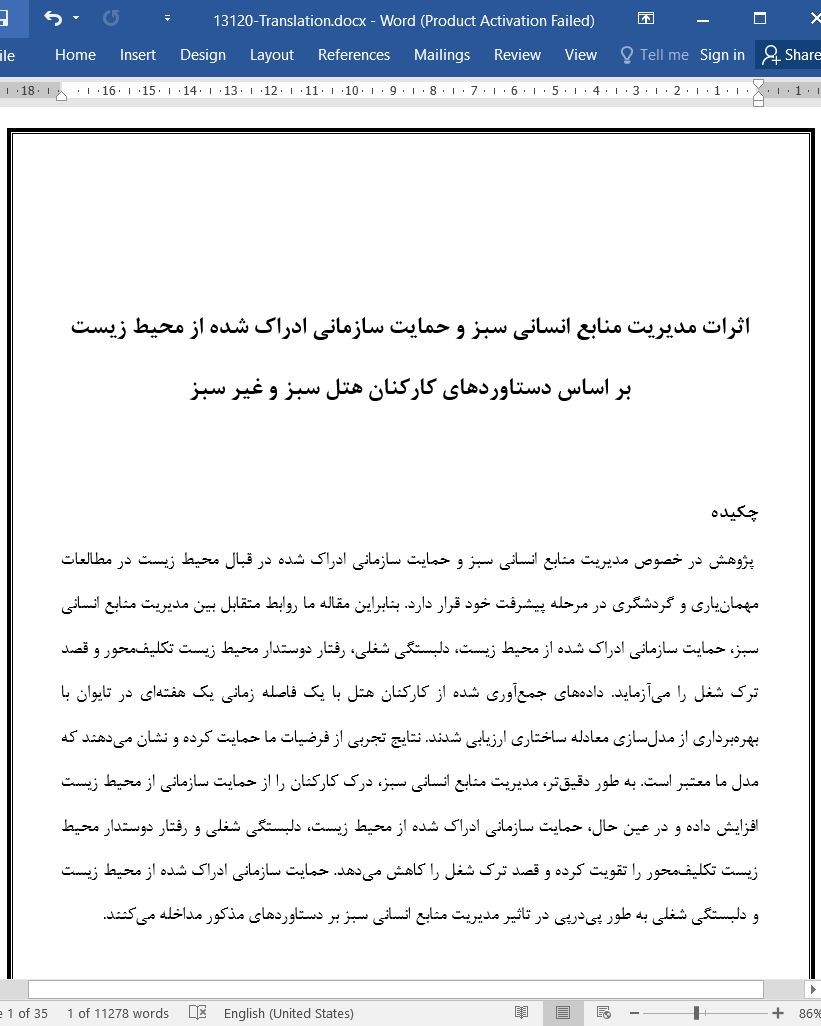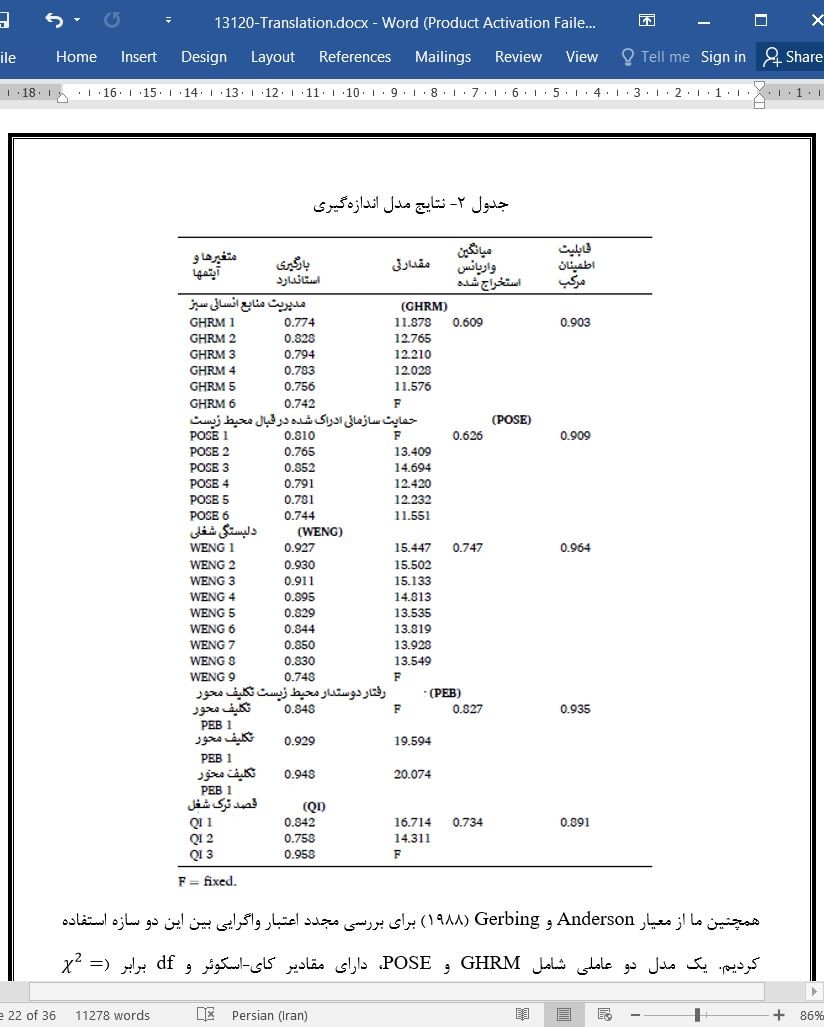
دانلود مقاله اثرات مدیریت منابع انسانی سبز و حمایت سازمانی ادراک شده از محیط زیست
چکیده
پژوهش در خصوص مدیریت منابع انسانی سبز و حمایت سازمانی ادراک شده در قبال محیط زیست در مطالعات مهمانیاری و گردشگری در مرحله پیشرفت خود قرار دارد. بنابراین مقاله ما روابط متقابل بین مدیریت منابع انسانی سبز، حمایت سازمانی ادراک شده از محیط زیست، دلبستگی شغلی، رفتار دوستدار محیط زیست تکلیفمحور و قصد ترک شغل را میآزماید. دادههای جمعآوری شده از کارکنان هتل با یک فاصله زمانی یک هفتهای در تایوان با بهرهبرداری از مدلسازی معادله ساختاری ارزیابی شدند. نتایج تجربی از فرضیات ما حمایت کرده و نشان میدهند که مدل ما معتبر است. به طور دقیقتر، مدیریت منابع انسانی سبز، درک کارکنان را از حمایت سازمانی از محیط زیست افزایش داده و در عین حال، حمایت سازمانی ادراک شده از محیط زیست، دلبستگی شغلی و رفتار دوستدار محیط زیست تکلیفمحور را تقویت کرده و قصد ترک شغل را کاهش میدهد. حمایت سازمانی ادراک شده از محیط زیست و دلبستگی شغلی به طور پیدرپی در تاثیر مدیریت منابع انسانی سبز بر دستاوردهای مذکور مداخله میکنند.
1- مقدمه
در یک بازار بسیار رقابتی، مدیران مهمانیاری متوجه شدهاند که توجه به حفاظت از محیط زیست و تحریک رفتارهای دوستدار طبیعت در بین کارکنانشان، یکی از نشانههای مهم سرمایهگذاری شرکت در حفظ و پایداری محیط زیست به شمار میرود (Sharma et.al. 2020). گرچه برخی هتلها برای سیاستهای پایداری محیط زیست به اندازه دستاوردهای تجاریشان، ارزش قایل نیستند (Khatter et.al. 2021)، اما علاقه به مدیریت سبز و بقا و پایداری محیط زیست در صنعت مهمانیاری رو به افزایش است. برای مثال، شرکت گردشگری ماریوت اینترنشنال، طرحهایی ابتکاری در پایداری زیستمحیطی در چهار حوزه مثل "پرورش جهان ما"، "توانمندسازی از طریق کسب فرصت"، "پایدار ساختن عملیات پاسخگو"، "استقبال از همه و توسعه حقوق بشر" در برنامه اهداف اثر اجتماعی و پایداری برای سال 2025 اجرا کرده است (Marriott 2021). سرمایهگذاری بر روی پرسنل از طریق ایجاد شرایط شغلی مطلوب و اقدامات نوآورانه در حوزه پایداری محیط زیست، وجود سیاستهای مدیریت منابع انسانی سبز (GHRM) و ارتقای فعالیتهای پایدار کارکنان شرکت را نشان میدهد (Umrani et.al 2020; Ramus 2011).
GHRM که مسیر برنامهریزیشدۀ سیستماتیک سیاستهای مدیریت منابع انسانی با اهداف زیستمحیطی سازمانی را مشخص میکند (Jabbour 2013; pp.147-148)، دستاوردهای زیستمحیطی و سبزمحور کارکنان را توسعه میدهد (Ubeda-Garcia et.al 2021a; Nisar et.al 2021). درک کارکنان از سیاستهای منابع انسانی سبز، مبنایی برای حمایت شرکت از محیط زیست به شمار میرود (Aboramadan and Karatepe 2021; Ahmed et.al 2021b). حمایت سازمانی ادراک شده از محیط زیست (POSE)، باور ویژه کارکنان از میزان ارزشی را نمایان میسازد که سازمان برای مشارکت آنان در حفظ محیط زیست قایل میشود (Lamm et.al 2015; p.209) و منجر به پیامدهای مثبت سبز و غیر سبز (مثل رضایت شغلی، کاهش تمایل به ترک شغل، رفتار شهروندی سازمانی در قبال محیط زیست، OCB-E) میگردد (Lam metal. 2015; Paille and Meija-Morelos 2019). با وجود چنین درکی، پژوهشها در حوزه مهمانیاری و گردشگری همچنان فاقد شواهدی در خصوص عواقب مثبت سبز و غیر سبز بالقوه GHRM و POSE در بین کارکنان هتل هستند (Aboramadan and Karatepe 2021; Nisar et.al 2021; Umrani et.al 2020). این بسیار عجیب است زیرا مدیریت نمیتواند به اهداف پایداری محیط زیست سازمان بدون مداخله فعال کارکنان دست یابد (Kalyar et.al 2021; Karatepe et.al 2020).
5.4-محدودیتها و پژوهش آینده
نتایج ما بایستی از منظر چند محدودیت بررسی شوند. اولاً مقاله ما PEB تکلیفمحور و قصد ترک شغل را به عنوان پیامدهایی از GHRM، POSE، WENG آزموده است. دستاوردهای سازمانی ارزشمند گوناگونی وجود دارند که میتوان آنها را در پژوهشهای آتی آزمود. برای مثال، جهت توسعه بیشتر مبنای اطلاعات فعلی، مطالعات آتی میتوانند ارزیابی کنند آیا POSE و WENG به طور متوالی در تاثیر GHRM بر سایر پیامدهای سبز و غیر سبز مهمی مثل خلاقیت، عملکرد سبز هتل، عملکرد سازگار، رفتار بیملاحظه، عملکرد احیای سبز و رفاه کارکنان، مداخله میکنند یا خیر (Ahmed et.al. 2021a,b; Darban et.al 2022; Hartline and Ferrell 1996; Kalyar et.al 2021; Karatepe et.al 2020; Wood et.al 2021).
Abstract
Research about green human resource management and perceived organizational support for the environment in the hospitality and tourism literature is in its development stage. Therefore, our paper tests the interrelationships of green human resource management, perceived organizational support for the environment, work engagement, task-related pro-environmental behavior, and quitting intentions. Data gathered from hotel employees with a time lag of one week in Taiwan were assessed tapping structural equation modeling. The empirical findings offer strong support for hypotheses and suggest that our model is viable. More precisely, green human resource management enhances employees’ perceptions of organizational support for the environment, while perceived organizational support for the environment fosters work engagement and task-related pro-environmental behavior and reduces quitting intentions. Perceived organizational support for the environment and work engagement sequentially mediate the effect of green human resource management on the aforesaid outcomes.
1. Introduction
In a strict competitive marketplace, hospitality managers realize that paying attention to the preservation of the environment and activating employees’ eco-friendly behaviors are among the important indicators of the company’s investment in environmental sustainability (e.g., Sharma et al., 2020). Though some hotels do not value environmental sustainable practices as much as commercial outcomes (Khatter et al., 2021), there is an increasing interest in green management and environmental sustainability in the hospitality industry. For instance, Marriott International has sustainability initiatives in four areas such as “nurturing our world”, “empowering through opportunity”, “sustaining responsible operation”, and “welcoming all and advancing human rights” in the sustainability and social impact goals program for 2025 (Marriott, 2021). Investing in employees through favorable job conditions and the environmental sustainability program highlights the presence of green human resource management (GHRM) practices and the company’s promotion of its employees’ sustainable actions (cf. Umrani et al., 2020; Ramus, 2011).
GHRM, which denotes “…the systematic, planned alignment of typical human resource management practices with the organization’s environmental goals…” (Jabbour, 2013, pp. 147–148), enhances employees’ green-related and environmental outcomes (e.g., Úbeda-García et al., 2021a; Nisar et al., 2021). Employees’ perceptions of green human resource practices represent the basis for the environmental support provided by the company (Aboramadan and Karatepe, 2021; Ahmed et al., 2021b). Perceived organizational support for the environment (POSE) denotes “…the specific beliefs held by employees concerning how much the organization values their contributions toward sustainability” (Lamm et al., 2015, p. 209) and results in green and non-green positive consequences (e.g., job satisfaction, diminished proclivity to quit, and organizational citizenship behavior for the environment, OCB-E) (Lamm et al., 2015; Paill´e and Meija-Morelos, 2019). Despite this realization, the hospitality and tourism research still lacks evidence about the potential green and non-green positive consequences of GHRM and POSE among hotel employees (Aboramadan and Karatepe, 2021; Nisar et al., 2021; Umrani et al., 2020). This is surprising because management cannot achieve the organization’s environmental sustainability goals without the active involvement of employees (Kalyar et al., 2021; Karatepe et al., 2020).
5.4. Limitations and future research
The results should be considered in view of several limitations. First, our paper tested task-related PEB and quitting intentions as the consequences of GHRM, POSE, and WENG. There are various organizationally valued outcomes that could be tested in future research. For example, to further enhance the current knowledge base, future studies could assess whether POSE and WENG serially mediate the effect of GHRM on other critical green and non-green outcomes such as green creativity, hotel’s green performance, adaptive performance, nonattendance behavior, green recovery performance, and employees’ well-being (Ahmed et al., 2021a,b; Darban et al., 2022; Hartline and Ferrell, 1996; Kalyar et al., 2021; Karatepe et al., 2020; Wood et al., 2021).
H1. GHRM relates positively to hotel employees’ POSE.
H2. POSE relates positively to hotel employees’ WENG.
H3. POSE relates positively to hotel employees’ task-related PEBs.
H4. POSE relates negatively to hotel employees’ quitting intentions.
H5. WENG relates positively to hotel employees’ task-related PEBs.
H6. WENG relates negatively to hotel employees’ quitting intentions.
H7. POSE and WENG sequentially mediate the impact of GHRM on task-related PEBs.
H8. POSE and WENG sequentially mediate the impact of GHRM on quitting intentions.
-H1 GHRM نسبت مستقیمی با POSE کارکنان هتل دارد.
H2 - POSE ارتباط مستقیم و مثبتی با WENG کارکنان دارد.
H3- POSE رابطه مستقیمی با PEBهای تکلیفمحور کارکنان هتل دارد.
H4 - POSE رابطه معکوسی با تمایل به ترک شغل دارد.
H5-WENG نسبت مستقیمی با PEBهای تکلیفمحور کارکنان هتل دارد.
H6-WENG نسبت معکوسی با میل کارکنان به ترک محل کار دارد.
H7-POSE و WENG به طور پیدرپی در تاثیر GHRM بر PEBهای تکلیفمحور مداخله میکنند.
H8-POSE و WENG به طور پیدرپی در تاثیرGHRM بر قصد ترک شغل مداخله میکنند.
Green human resource management (GHRM)
Perceived organization support for the environment (POSE)
Work engagement (WENG)
Task-related pro-environmental behavior (PEB)
Quitting intentions (QI)
چکیده
1- مقدمه
1.1-هدف
1.2-مشارکت
2- چارچوب نظری، فرضیات و مدل پژوهش
2.1-تمرکز نظری
2.2-فرضیات
2.2.1-مدیریت منابع انسانی سبز و حمایت سازمانی ادراک شده از محیط زیست
2.2.2-حمایت سازمانی ادراک شده از محیط زیست و دستاوردهای کاری سبز و غیر سبز
2.2.3-دلبستگی شغلی و دستاوردهای کاری سبز و غیر سبز
2.2.4-نقش مداخلهگری پیدرپی حمایت سازمانی ادراک شده و دلبستگی شغلی
2.3-مدل پژوهش
3- روش
3.1-نمونه و رویه
3.2-کاربرد ابزار
3.2.1-مدیریت منابع انسانی سبز
3.2.2-حمایت سازمانی ادراک شده از محیط زیست
3.2.3-دلبستگی شغلی
3.2.4-رفتار دوستدار محیط زیست تکلیفمحور
3.2.5-تمایل به ترک شغل
3.2.6-متغیرهای کنترل
3.3-راهبرد آنالیزها
4-نتایج
4.1-مدل اندازهگیری
4.2- بررسی واریانس روش مشترک
4.3-تست فرضیات
5-بحث
5.1-یافتههای کلی
5.2-مفاهیم نظری
5.3-مفاهیم مدیریتی
5.4-محدودیتها و پژوهش آینده
منابع
Abstract
1- INTRODUCTION
2- LITERATURE REVIEW AND CONCEPTUAL DEVELOPMENT
2.1 Social identity theory
2.2 Customer engagement
2.3 Brand credibility/identification interface
2.4 Brand value congruence/identification interface
2.5 Brand experience/identification interface
2.6 Brand identification/advocacy interface
2.7 Brand identification/brand attachment interface
2.8 Brand identification/brand loyalty interface
2.9 Moderating role of customer engagement
3- METHODOLOGY
3.1 Survey instrument
3.2 Sampling and data collection
3.3 Common method variance
4- ANALYSIS AND RESULTS
4.1 Confirmatory factor analysis
4.2 Reliability and validity assessment
4.3 Structural equation model results
4.4 Hypothesis testing results
4.5 Moderating effect of customer engagement
5- DISCUSSION AND IMPLICATIONS
5.1 Theoretical implications
5.2 Managerial implications
5.3 Limitations and future research
ACKNOWLEDGMENTS
REFERENCES
این محصول شامل پاورپوینت ترجمه نیز می باشد که پس از خرید قابل دانلود می باشد. پاورپوینت این مقاله حاوی 20 اسلاید و 6 فصل است. در صورت نیاز به ارائه مقاله در کنفرانس یا سمینار می توان از این فایل پاورپوینت استفاده کرد.
در این محصول، به همراه ترجمه کامل متن، یک فایل ورد ترجمه خلاصه نیز ارائه شده است. متن فارسی این مقاله در 7 صفحه (1800 کلمه) خلاصه شده و در داخل بسته قرار گرفته است.
علاوه بر ترجمه مقاله، یک فایل ورد نیز به این محصول اضافه شده است که در آن متن به صورت یک پاراگراف انگلیسی و یک پاراگراف فارسی درج شده است که باعث می شود به راحتی قادر به تشخیص ترجمه هر بخش از مقاله و مطالعه آن باشید. این فایل برای یادگیری و مطالعه همزمان متن انگلیسی و فارسی بسیار مفید می باشد.
بخش مهم دیگری از این محصول لغت نامه یا اصطلاحات تخصصی می باشد که در آن تعداد 20 عبارت و اصطلاح تخصصی استفاده شده در این مقاله در یک فایل اکسل جمع آوری شده است. در این فایل اصطلاحات انگلیسی (تک کلمه ای یا چند کلمه ای) در یک ستون و ترجمه آنها در ستون دیگر درج شده است که در صورت نیاز می توان به راحتی از این عبارات استفاده کرد.
- ترجمه فارسی مقاله با فرمت ورد (word) با قابلیت ویرایش و pdf بدون آرم سایت ای ترجمه
- پاورپوینت فارسی با فرمت pptx
- خلاصه فارسی با فرمت ورد (word)
- متن پاراگراف به پاراگراف انگلیسی و فارسی با فرمت ورد (word)
- اصطلاحات تخصصی با فرمت اکسل



